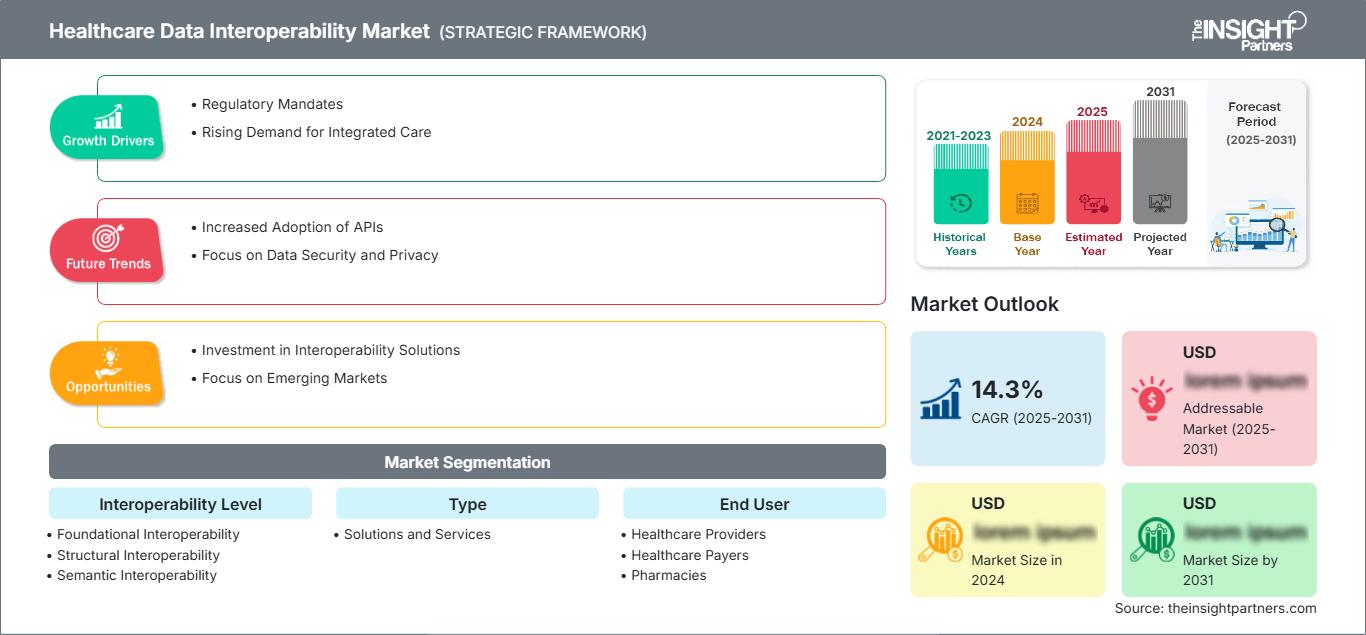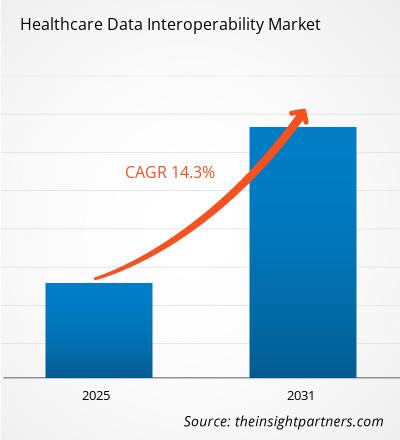页面已更新 :
Jan 2025
预计医疗数据互操作性市场在 2025 年至 2031 年期间的复合年增长率为 14.3%,市场规模将从 2024 年的 XX 百万美元扩大到 2031 年的 XX 百万美元。
该报告按互操作性级别(基础互操作性、结构互操作性和语义互操作性)、类型(解决方案和服务)、最终用户(医疗保健提供者、医疗保健付款人和药房)细分。全球分析进一步细分为区域和主要国家。该报告以美元提供了上述分析和细分的价值。
报告目的
Insight Partners 发布的《医疗数据互操作性市场》报告旨在描述当前的格局和未来的增长、主要驱动因素、挑战和机遇。这将为各种商业利益相关者提供见解,例如:
- 技术提供商/制造商:了解不断变化的市场动态并了解潜在的增长机会,使他们能够做出明智的战略决策。
- 投资者:对市场增长率、市场财务预测和整个价值链中存在的机会进行全面的趋势分析。
- 监管机构:规范市场政策和警察活动,旨在最大限度地减少滥用,维护投资者的信任和信心,维护市场的完整性和稳定性。
医疗数据互操作性市场细分 互操作性级别
- 基础互操作性
- 结构互操作性
- 语义互操作性
类型
- 解决方案和服务
最终用户
- 医疗保健提供商
- 医疗保健付款人
- 药店
地理位置
- 北美
- 欧洲
- 亚太地区
- 中东和非洲
- 南美洲和中美洲
自定义此报告以满足您的要求
您将免费获得任何报告的定制,包括本报告的部分内容,或国家级分析、Excel 数据包,以及为初创企业和大学提供超值优惠和折扣
医疗数据互操作性市场: 战略洞察

- 获取本报告的主要市场趋势。这个免费样本将包括数据分析,从市场趋势到估计和预测。
医疗数据互操作性市场增长动力
- 监管要求:政府和监管机构越来越关注医疗系统互操作性的需求。美国《21世纪治愈法案》等倡议要求医疗机构采用可互操作的系统,以改善患者获取健康信息的渠道并加强护理协调。
- 对综合护理的需求不断增长:随着医疗保健向基于价值的护理模式转变,对综合护理解决方案的需求日益增长,以便在医疗服务提供者之间实现无缝数据共享。互操作性促进了医疗专业人员之间的沟通与协作,从而改善了患者的治疗效果。
医疗数据互操作性市场未来趋势
- API 采用率不断提高:未来 API 的使用将会增加。这将使医疗保健领域的应用程序能够更有效地通信和共享信息。通过使用 API,可以实现更多能够提高不同平台之间互操作性的创新解决方案。
- 关注数据安全和隐私:数据共享将日益增多,数据安全和患者隐私将受到更多重视。互操作性解决方案将整合增强的安全功能,例如加密和访问控制,以保护敏感的健康信息。
医疗数据互操作性市场机遇
- 互操作性解决方案投资:医疗保健机构一直在加大对互操作性解决方案的投资,以提高运营效率并改善患者的护理质量。拥有创新且可扩展的互操作性解决方案的公司可以最大限度地利用这一机遇。
- 关注新兴市场:随着新兴市场医疗保健体系的发展,有机会根据其特定需求推出量身定制的互操作性解决方案。
医疗数据互操作性市场区域洞察
The Insight Partners 的分析师已详尽阐述了预测期内影响医疗保健数据互操作性市场的区域趋势和因素。本节还讨论了北美、欧洲、亚太地区、中东和非洲以及南美和中美洲的医疗保健数据互操作性市场细分和地域分布。
医疗数据互操作性市场报告范围
| 报告属性 | 细节 |
|---|---|
| 市场规模 2024 | US$ XX million |
| 市场规模 2031 | US$ XX Million |
| 全球复合年增长率 (2025 - 2031) | 14.3% |
| 历史数据 | 2021-2023 |
| 预测期 | 2025-2031 |
| 涵盖的领域 |
By 互操作性级别
|
| 覆盖地区和国家 | 北美
|
| 市场领导者和主要公司简介 |
|
医疗数据互操作性市场参与者密度:了解其对业务动态的影响
医疗保健数据互操作性市场正在快速增长,这得益于终端用户需求的不断增长,而这些需求的驱动因素包括消费者偏好的不断变化、技术进步以及对产品优势的认知度不断提高。随着需求的增长,企业正在扩展其产品线,不断创新以满足消费者需求,并利用新兴趋势,从而进一步推动市场增长。

- 获取 医疗数据互操作性市场 主要参与者概述
主要卖点
- 全面覆盖:该报告全面涵盖了对医疗数据互操作性市场的产品、服务、类型和最终用户的分析,提供了整体格局。
- 专家分析:该报告基于对行业专家和分析师的深入了解而编写。
- 最新信息:由于该报告涵盖了最新信息和数据趋势,因此确保了业务相关性。
- 定制选项:此报告可以根据特定客户要求进行定制,并适合业务策略。
因此,有关医疗数据互操作性市场的研究报告可以帮助引领解码和理解行业情景和增长前景的道路。尽管可能存在一些合理的担忧,但本报告的总体优势往往大于劣势。
- 历史分析(2 年)、基准年、预测(7 年)及复合年增长率
- PEST和SWOT分析
- 市场规模、价值/数量 - 全球、区域、国家
- 行业和竞争格局
- Excel 数据集
近期报告
相关报告
客户评价
购买理由
- 明智的决策
- 了解市场动态
- 竞争分析
- 客户洞察
- 市场预测
- 风险规避
- 战略规划
- 投资论证
- 识别新兴市场
- 优化营销策略
- 提升运营效率
- 顺应监管趋势
我们的客户































87-673-9708

ISO 9001:2015



 获取免费样品 - 医疗数据互操作性市场
获取免费样品 - 医疗数据互操作性市场